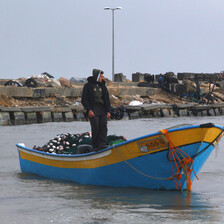The Electronic Intifada Gaza City 23 December 2011

The Amal Institute for Orphans is home to 120 orphans.
APA imagesGAZA CITY (IPS) - Yousef walks barefoot into a children’s room with four beds and points to a Snoopy-blanketed bed by the window. “That’s where I sleep,” he says. A red remote-controlled toy race car sits atop a new mini-laptop. The closet is full of clothes, a pot of soup simmering on the gas range in the spacious kitchen, and the wooden dining table is piled with seasonal fruit.
Unlike the overwhelming majority of children in the Gaza Strip, the seven-year-old’s bare feet are not a result of poverty. Quite the opposite, his home in the Rafah-based SOS Children’s Village, run by an international organization, does not leave him wanting for shoes, clothes, school supplies, regular meals or a safe abode.
His home is new, has plenty of natural light and is larger than the cramped refugee camp homes in which more than 75 percent of Gaza’s population lives.
Orphaned by Israel
Yousef, his brother, and his younger sister are among the Gaza Strip’s estimated 53,000 orphans. More than 2,000 other children were orphaned during the 2008-2009 Israeli war on Gaza. An orphan here is defined as a child who has lost his father or both parents, as men are traditionally the income-generators in Gaza.
Yousef’s father died of natural causes, and his mother lost a leg after being injured during the war on Gaza. So Yousef and his siblings were more apt to join the increasing numbers of children selling trinkets in Gaza’s streets, or scouring dumps and streets for items that may be sold.
“The family was already very poor. Now his mother has no income and no way to provide for her children,” says Samar, an employee at the SOS Children’s Village. The children would not have finished school, she said let alone have been cared for adequately.
With donations from groups and individual sponsors, children like Yousef are able to stay at the orphanage where they attend a nearby regular school, learn life skills for their future independence, and have their university tuition paid. Their medical needs are met, and they are encouraged to mingle with non-orphan children and to visit their real families on weekends.
“At any time their mothers can visit them here at the village,” says Samar. The need for such sponsorship, whether home-based or institute-based, is immense. Some programs, like the Dar al-Yateem association, sponsor orphans who remain in their families’ homes. Dar al-Yateem has eight branches throughout the Strip which provide child sponsorship, transportation to schools, school uniforms and study materials and daily meals for orphan children.
During Muslim holidays, the association gives food to the orphans and other impoverished families and organizes activities for the children throughout the year.
Other Islamic charities throughout Gaza fill similar roles of basic child sponsorship and emergency assistance.
The needs of Gaza’s orphans have increased so dramatically over the years that many more international charities are taking active roles in child sponsorship, extending the scope to widowed mothers.
Dying from depression
“One of the problems we face is that people sometimes focus only on orphans whose parents were martyred by Israeli attacks,” says Hazem Sarraj, chairman of the Amal Institute for Orphans in Gaza City.
“But we have many more orphans whose parents died of natural causes or from reasons related to the siege imposed on Gaza. Many people in Gaza suffer from depression, due to our situation here. Some die from it.”
Other siege-related deaths include patients denied exit permits for treatment outside of Gaza, accidents and fires related to misuse of generators during the daily power cuts, and men and youths killed in tunnel collapses or electrocution by poor wiring in the narrow tunnels.
“We have 120 orphans, ages five to 18, who live at our institute,” says Sarraj. “They eat and sleep here, go to regular schools, and visit their families on weekends.”
Before many countries cut their ties with the Gaza Strip after Israel imposed its siege in early 2006, the Amal Institute, established in 1949, was functioning well and expanding its programs.
“All development in our institute has stopped since the siege,” says Sarraj. “The buildings we currently have we built with money from the Islamic bank and foreign NGOs [non-governmental organizations] and donors, before the blockade.”
The institute ensures the orphans’ needs are met financially, educationally, medically and socially. But Sarraj worries about the institute’s funding.
“Our means are very limited. Do you know what it takes to care for 120 orphans, to provide them with food, clothes, medicine and everything they need? We have to pay our employees’ salaries as well. We are independent, not political, but the siege is punishing us, our orphans. We used to receive more donations before the siege, but now we get very little.”
The institute continues to run under the siege, providing quality care and offering extras like the chance for orphans to study martial arts and music, and opening day programs to more than 500 non-orphan children in the city. Like most societies helping orphans, counseling is given to address traumas Gaza’s children, particularly orphans, endure.
“Until now we are still suffering from the last war on Gaza,” says Sarraj. “We are living as though in a bad dream.”
All rights reserved, IPS - Inter Press Service (2011). Total or partial publication, retransmission or sale forbidden.





